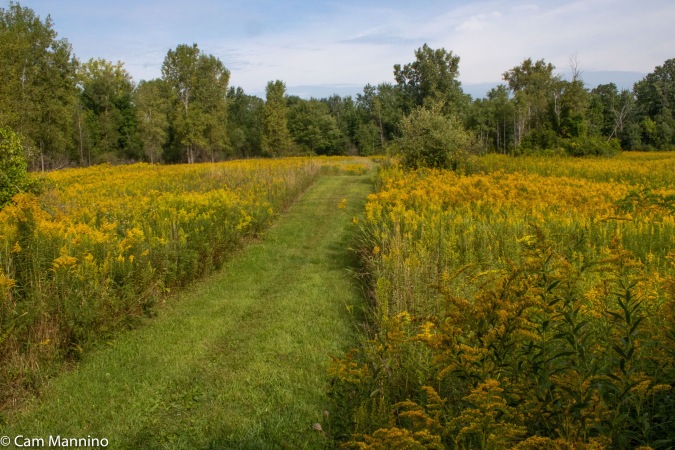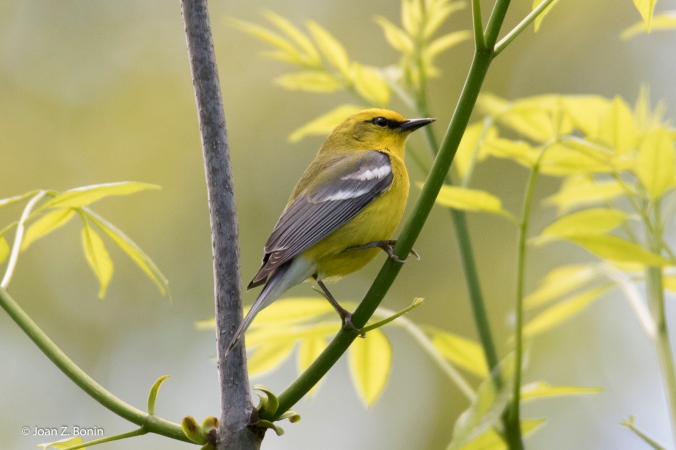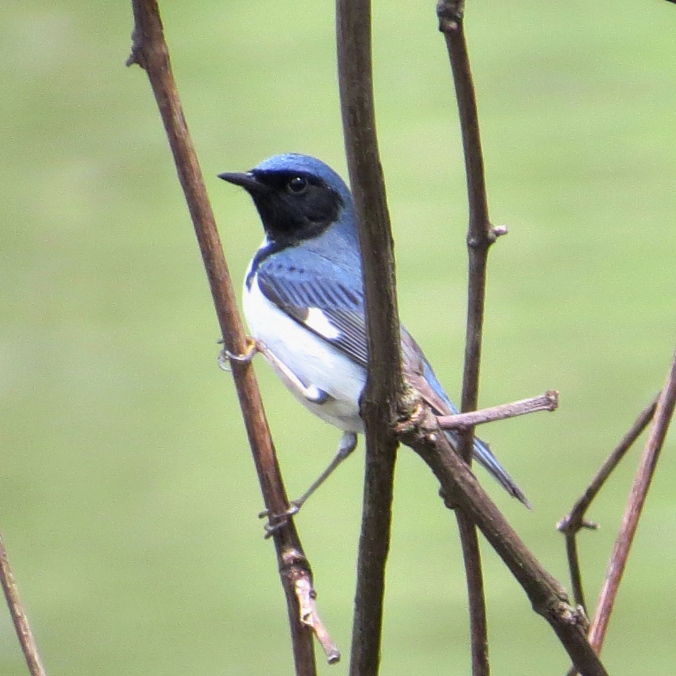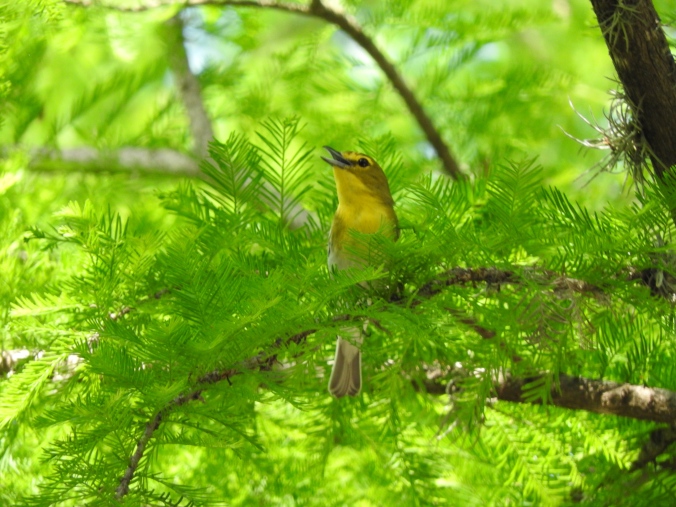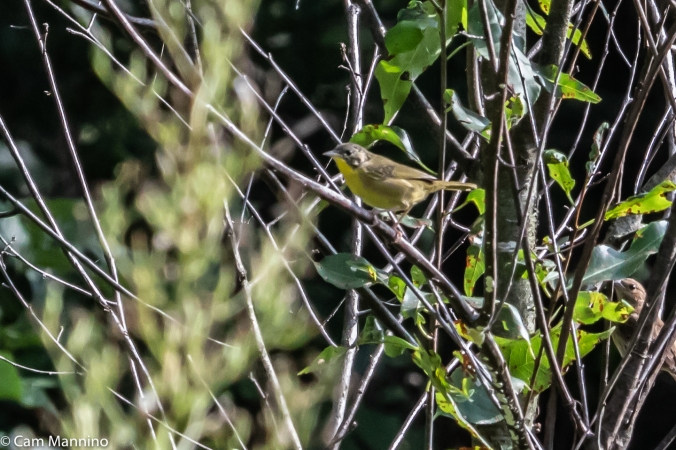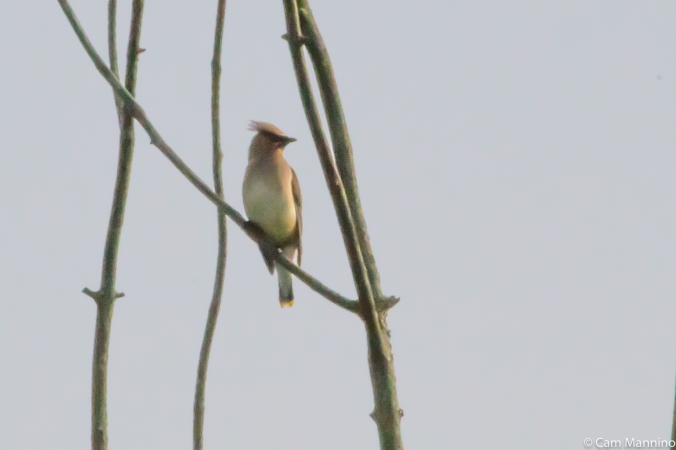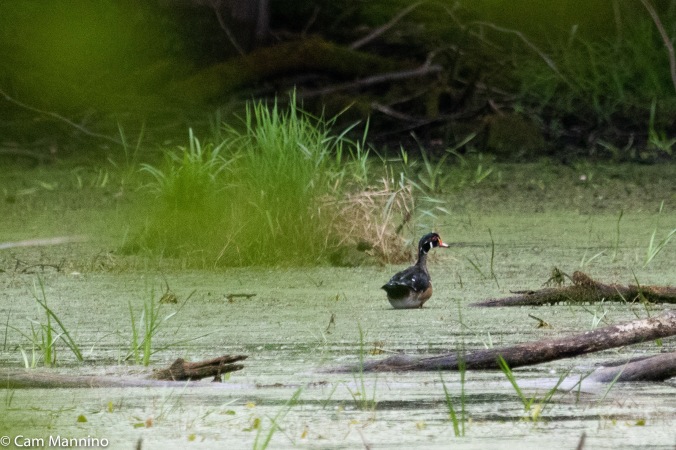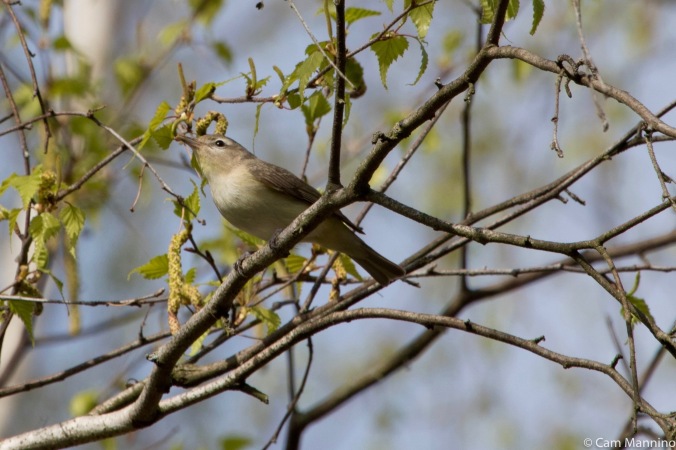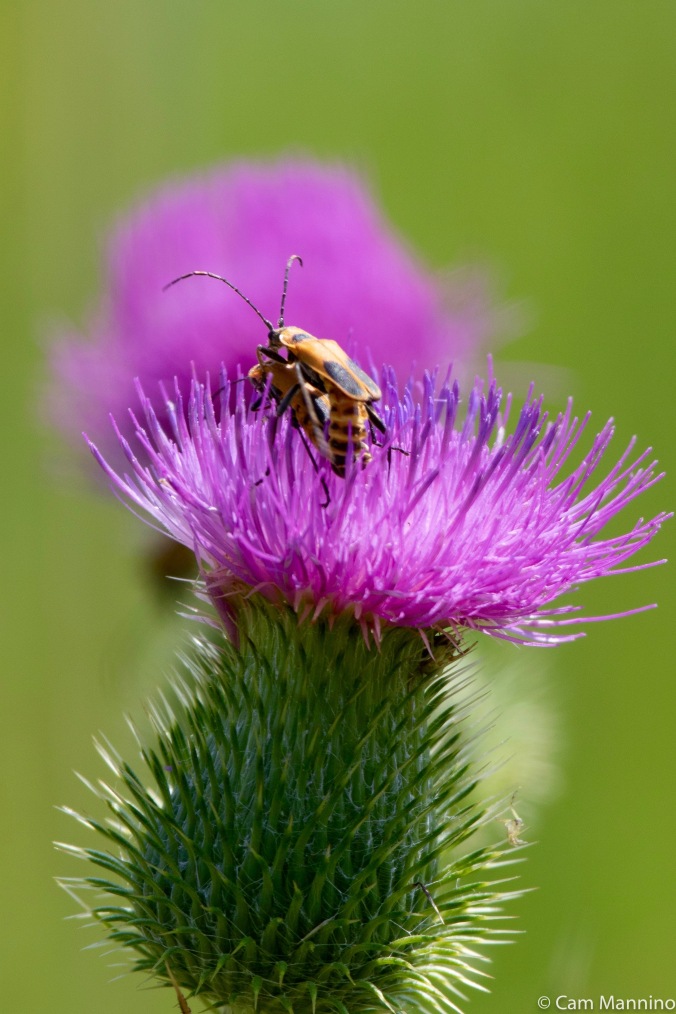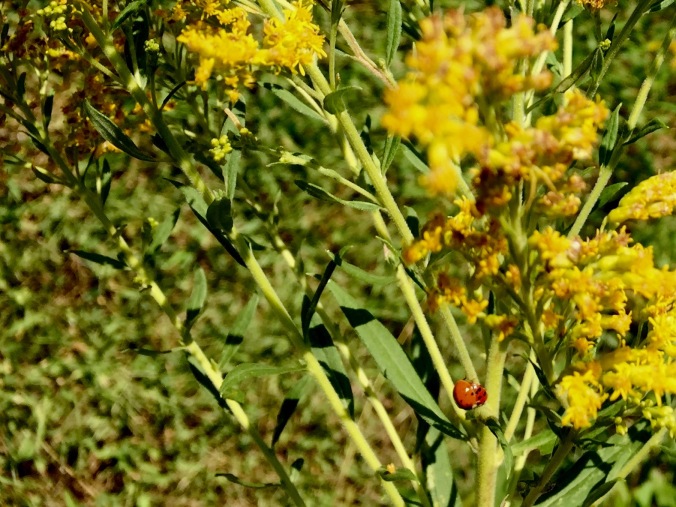Goldenrod! A variety of different Goldenrods gild Cranberry Lake Park in early autumn. Their bounty of nectar and pollen and the insects they attract make Cranberry Lake an ideal stopover for migrating birds and butterflies as they prepare for their long journeys. So cheer for Goldenrods as they feed wildlife, but don’t blame them for your fall allergies – blame ragweed!
Year ’round birds and summer residents have almost finished molting and are also stocking up energy for winter or the migration. And a surprising number of insects are also preparing by busily mating one last time, leaving behind eggs or chrysalises that can bring forth young next spring and summer. Lots going on within this carpet of gold!
Migrating Birds – Some Stayed All Summer; Some Just Stop Briefly for Rest & Refueling
Now’s the time to train your binoculars on any shaking leaf you see. It might be a fall migrator! Colorful, tiny warblers and vireos that are just passing through on their way south are well worth a pause to look into the shrubbery, as you’ll see below! But don’t forget to wish “bon voyage” to the migrators who arrived last spring and sojourned with us all summer. Many are finishing up their molts and readying for long journeys to the southern US or even Central and South America. We saw all of the birds shown below on the bird walk last week at Cranberry Lake Park.
Migrators from Farther North: Just Passing Through
The trees are aquiver with fall migrators, travelers that bred up north and only briefly stop to rest and refuel around our woods and meadows. The most colorful ones that we often hear but can’t see are warblers and vireos. These little birds travel on the night wind because it’s safer. Hawks, eagles, and other birds that might see these small birds as food migrate during the day so that they can ride the thermals!
My camera and I are not quite quick enough to catch a lot of these tiny, fast-moving birds. So to share them with you, I’m relying on photos of other photographers with the skills, equipment and sometimes sheer luck to capture these little beauties!
The Blue-winged Warbler (Vermivora cyanoptera) breeds at Cranberry Lake Park, but the birds we’ve seen in the last week were probably moving through from further north. This fine bird shows off its black eyeline and blue wings with white wingbars in a gorgeous photo taken by gifted local photographer Joan Bonin:
This photo of the striking Black-throated Blue Warbler (Setophaga caerulescens) is by gifted iNaturalist photographer Jeff Skrent at iNaturalist.org.
A Yellow-throated Vireo ( Vireo flavifrons) from another generous iNaturalist photographer who uses the single name, paloma.
A Nashville Warbler (Leiothlypis ruficapilla) was also too quick for me. But here’s one I did manage to catch as it passed through in the autumn of 2016 on its way to Central America.
Summer Visitors: The Migrators that Come Here to Raise Their Young
Some avian migrators see our parks as a great place to raise their young, so they come in the spring and stay for the summer. Having finished breeding and molting, they are now preparing to leave for points south. The male Common Yellowthroat’s (Geothlypis trichas) “Witchedy – witchedy” song accompanied me often during the summer months as he and his mate raised their young. But you may here his “chuck” call as he hops among the branches stocking up on insect protein before leaving for Florida.

The Common Yellowthroat stops singing its “witchedy-witchedy” song in the fall and prepares to migrate.
Both the male Common Yellowthroat and his mate did a complete molt in July or August and now have fresh feathers for the trip. She’s bit more secretive than the male as she feeds on beetles, ants, bees (!), dragonflies and grasshoppers within the golden fields. Usually she’ll leave a week or two later than the male.
Last spring the Wednesday morning birders heard a Black-throated Green Warbler (Setophaga virens) singing its mating song along the Hickory Lane at Cranberry Lake. And this week, the birders spotted one flitting high in the trees. Perhaps it nested here to raise its young, or it could be just passing through our parks in spring and fall. Here’s a photo I took of a male during the spring migration this year.
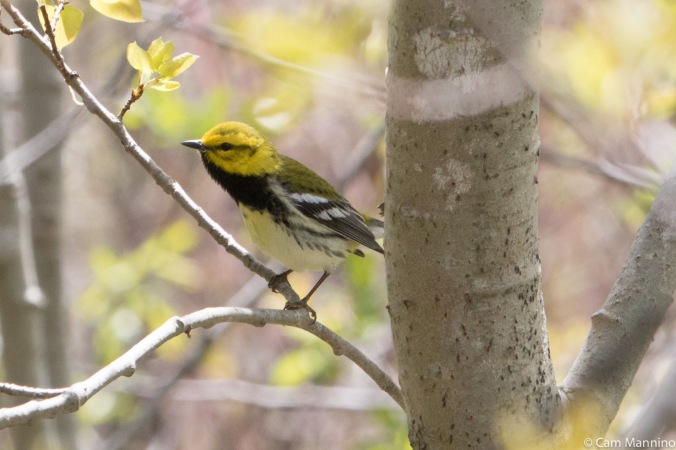
The Black-throated Green Warbler may have nested here this summer or he may be just passing through both in the spring and fall.
High in a snag, a Cedar Waxwing (Bombycilla cedrorum) paused briefly to survey the golden eastern meadow one afternoon. Many waxwings go into lower Canada to breed, but I’ve seen successful nests in our parks, too, so this one may have been a summer resident. Some will move south for the winter, but many waxwings will stick around during the cold months.
House Wrens (Troglodytes aedon) become quite secretive after breeding. But this one popped out of the greenery for a minute. It appears to have completed the late summer molt and is prepared to start south between now and mid-October.
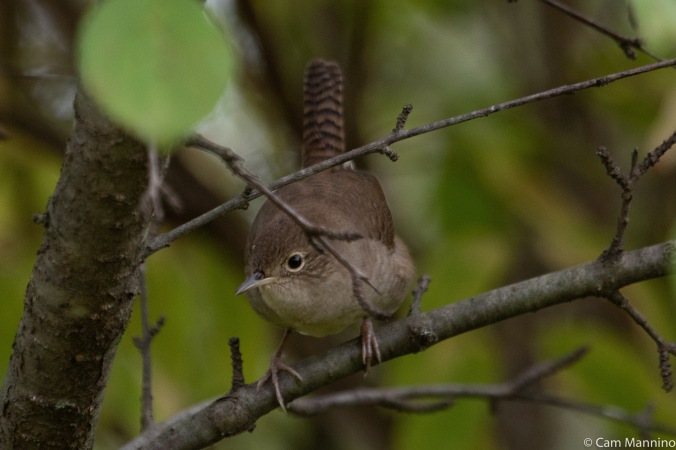
The House Wren has raised its young here, molted and will be leaving shortly for Florida and other southern states.
A curious juvenile Field Sparrow (Spizella pusilla) peeked at me from dense shrubbery along the trail, too. The migration of Field Sparrows is not always predictable. Some migrate, some don’t, and some migrate one year but not the next, according to the Stokes’ Guide to Bird Behavior (Vol.2). If this one does migrate, it may join a large flock with Chipping Sparrows as well as other Field Sparrows.

If this Field Sparrow chooses to migrate this year, it will probably join a larger flock. Or it may just stay put!
On one of my Cranberry walks, I spotted some Wood Ducks (Aix sponsa) far across a well-hidden wetland. They were males who’d chosen this secluded spot to begin their molt out of the summer “eclipse plumage” into their fancy choosing-a-mate plumage. This one looked a bit rough at the moment, but well on his way to his courting colors. As I explained in last week’s molting blog, males molt earlier in the summer to camouflage themselves as females and then molt again in the fall, a time when they compete for a mate to breed with in the spring.
I often hear, but rarely see, the vireos at Cranberry Lake. But I did get to see a Warbling Vireo (Vireo gilvus) in the spring. A rare treat, since it loves to sing high in the treetops! Its plumage is modest but its song is impressive! The birders saw one lingering in our park for a while before departing for points south.
Occasionally I get a quick look at a Red-eyed Vireo (Vireo olivaceus). But Bob Bonin, Joan’s husband and another gifted photographer, got a much better photo than I have so far! This week it too was hanging out with other migrators.
Butterfly Migrators
Birds, of course, are not the only creatures migrating through our parks this autumn. Monarch Butterflies (Danaus plexippus) fluttered everywhere at Cranberry Lake Park in the last few weeks. This “super-generation” of fragile creatures – the ones that will fly 3,000 miles to Mexico – were swooping and diving over the meadows at Cranberry Lake, feeding on the acres of Goldenrod. So glad that we provide these master migrators with such a feast!
The tattered Giant Swallowtail (Papilio cresphontes) below looks lightly worn. Let’s hope that attests to its having mated here this summer after its migration to Cranberry Lake. These huge butterflies seem to be expanding their range north. Possibly due to climate change, Michigan now often has frost-free Septembers. So if mating was successful, the caterpillars of this very large butterfly may survive inside their chrysalises and hatch in our parks next spring.

This Giant Swallowtail looks a bit tattered at the end of a summer at Cranberry Lake Park. Due to mating? Maybe.
Last Chance for Progeny! Insects Still Mating in the Meadows
Among the Goldenrod, insects seek out mates in a last ditch effort to leave offspring for next summer. A pair of Goldenrod Soldier Beetles (Chauliognathus pennsylvanicus) rendezvoused on a Bull Thistle (Cirsium vulgare) – a potentially risky place to mate since a bird might think they make a tasty contrast against the blossom!
A pair of tiny Pearl Crescent butterflies (Phyciodes tharos) also decided that a warm September afternoon provided the ideal time for mating.
And two Ladybugs chased around a Goldenrod stem, one frenetically holding on to the other. I couldn’t really determine whether they were mating or fighting! Clearly, one was more interested in escape and one was in hot pursuit. They were moving too fast for a great shot or a definite identification. My guess is that they were the invasive Asian Ladybugs (Harmonia axyridis). Unfortunately they are more common these days than our native Nine-spotted Ladybug (Coccinella novemnotata) and come in highly variable colors and patterns.
This tiny Red-legged Grasshopper (Melanoplus femurrubrum) had probably spent the night near the stalk of the Common Milkweed (Asclepias syriaca), wisely hidden from predators among its withering leaves. It will molt multiple times before mating and leaving eggs in the soil to emerge next summer.
The edge of a meadow, near a wetland, might be an ideal spot for a female Great Blue Skimmmer dragonfly (Libellula vibrans). She could be spreading her wings in hope of attracting a mate. If successful, the aquatic plants nearby could host her fertilized eggs. Or while waiting for a likely male, she might just have a great perch for hunting unsuspecting prey!

A female Great Blue Skimmer sunned herself on a cool morning, possibly trying to attract a mate – or just hunting for the next unwary insect!
Spider Art On a Misty Morning
Early fall mornings are an excellent time to appreciate the art of the spiders. Warm days followed by cool nights leave heavy dew on spider webs, and when the sun makes them visible, they are dazzling. How about this lovely creation of an Orb Weaver spider (family Araneidae) drooping with the weight of the dew but subtly reflecting the colors of the sun’s spectrum!
Another intriguing web, though not as beautiful, is cleverly constructed. The Funnel Web Spider (Circuria species) lays a sticky sheet of web across the grass, which would be difficult to see were it not for the dew. At the edge of the web, it weaves a tunnel where it lies in wait for unsuspecting prey. Above the sheet, it weaves an irregular network of silk designed to knock flying insects into its sticky net below. You can see the funnel at the back of this web below.

The Funnel Web Spider’s trap for flying insects with a nifty funnel in which the spider can wait for its prey unseen.
Frogs Underfoot!
As I skirted the edge of wetlands one Sunday, it seemed that a frog sprang out of the grass at every step! Most of them were Northern Leopard Frogs (Rana pipiens), their emerald green backs covered with circular black dots outlined in pale gold. Their dark eyes encircled with gold add to their glamour. Pinkish dorsolateral ridges are another distinguishing field mark. They shine like cloisonné in the deep grass!
Until last week, I’d never noticed Pickerel Frogs (Rana palustris) at Cranberry Lake. These smaller frogs have somewhat rectangular spots that line up along the frogs’ back in neat rows. They are smaller than Leopard frogs. They tend to be brown (though they are sometimes green too), so I’m fairly sure this is Pickerel frog below.

Pickerel Frogs have more rectangular spots in rows down their backs, rather than the more random round spots of Leopard Frogs. So I think this is Pickerel frog, but I’m not positive!
And Finally, the Native Plants that Make It All Possible!
The plants, though not as often noticed by hikers, provide sustenance for all these creatures as the base of the food web. Butterflies sip their nectar. Bees and wasps feed pollen to their young. Other insects munch on leaves or make winter homes in the stalks. Birds, reptiles, amphibians, and mammals eat all parts of plants, or the insects that live on them. So here’s a gallery of just a few of the plants that, along with the plentiful goldenrods, have bloomed in sun and shade to sustain the beauty and life of Cranberry Lake Park in late summer. (Use pause button for captions.)
Autumn Mornings: Not To Be Missed!
On our September bird walk at Cranberry Lake Park, we arrived on a cool fall morning. The previous day had been unseasonably warm, but a north wind sailed in overnight. The cool air had created heavy dew, leaving silver droplets that set the spider webs shining. The morning sun on the moist leaves created the fine mist you see above, rising from a meadow beyond the Hickory Lane. What a sight! – the makings of future clouds floating like silver smoke above the wildflowers. A wave of migratory warblers and other small birds had arrived on that night wind. The birders watched, binoculars up, as these travelers hopped busily in the branches, feeding on the plenty of insects attracted by fields full of blooming fall wildflowers. And all of this beauty is gratuitous – unearned, just gifted to us if we just put on our shoes and head out the door! Consider escaping from the busy-ness of life for just an hour this week. Let these beautiful fall days lure you to the parks and savor the gifts that nature so generously offers to all of us.
